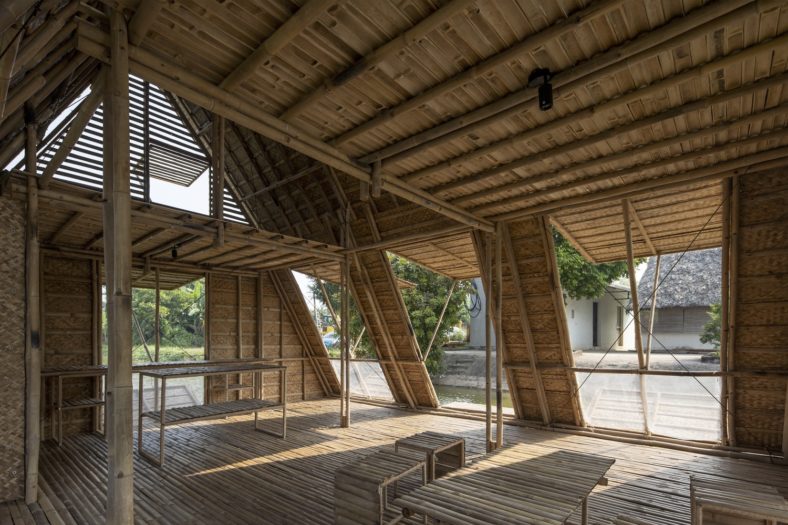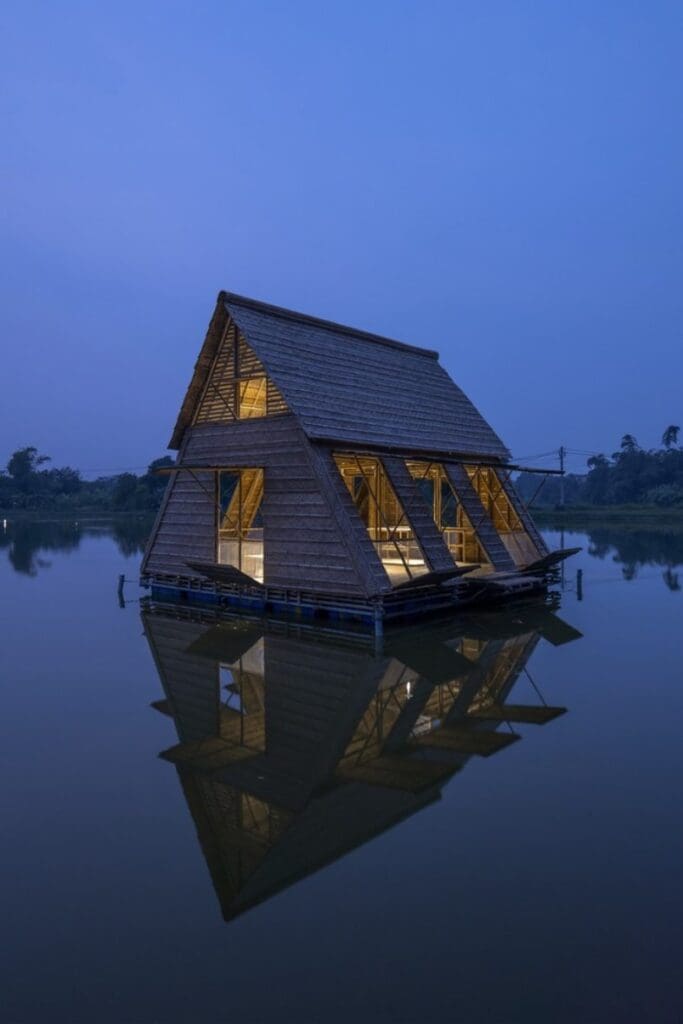Floating Bamboo Houses – A Logical Response To Sea Level Rise?
The floating bamboo house, designed by H&P Architects, offers a practical solution to the challenges posed by sea level rise in the Mekong Delta. With annual heavy flooding and the potential for permanent inundation of a significant portion of the delta with an 80-cm rise in sea level, these homes provide a means for livelihoods adapted to living with floods.
Drawing inspiration from traditional Vietnamese communal houses, known as Rong houses, the design incorporates vernacular materials such as solid core bamboo and local cladding materials that can withstand the region’s weather conditions. The compartmentalized interiors feature various functional spaces including living and dining areas, a kitchen, bath area, toilet, and an upper level for study and resting purposes.
By utilizing bamboo throughout the design, this housing solution demonstrates its versatility and establishes a strong material identity. Overall, these floating bamboo houses offer a sustainable and resilient approach to address sea level rise in the Mekong Delta.
Design Inspiration
The design of the floating bamboo house draws inspiration from traditional Vietnamese communal houses, specifically the Rong communal houses in Vietnam’s Central Highlands, which are known for their use in community ceremonies and administrative events. This sustainable architecture project not only aims to provide a solution to sea level rise but also focuses on cultural preservation and community engagement.
By incorporating elements from the Rong communal houses, the Floating Bamboo House showcases architectural innovation while maintaining a strong connection to its cultural roots. The design seeks to go beyond being just a home by contributing to different spatial programs that promote community activities and gatherings.
In addition to its cultural significance, this eco-friendly design is constructed using vernacular materials such as solid core bamboo held together with latches and ties. Local materials are used for cladding to withstand the harsh weather conditions of the Mekong Delta region. The exteriors of the stilt house are adorned with plastic bottles and guot grass, showcasing resourcefulness in utilizing recycled materials.
Furthermore, compressed weaved bamboo sheets are used on the floating house exteriors, highlighting the versatility of bamboo in different expressions. This innovative use of sustainable materials not only reduces environmental impact but also promotes a sense of harmony between architecture and nature.
Overall, the design of the floating bamboo house combines sustainable architecture, cultural preservation, community engagement, and architectural innovation into an eco-friendly solution for sea level rise. By drawing inspiration from traditional Vietnamese communal houses like Rong houses, this project demonstrates how architecture can adapt to environmental challenges while honoring local heritage.
Use of Vernacular Materials
Utilizing local materials and traditional construction techniques, the design of the floating bamboo house demonstrates a conscious effort to incorporate local elements that withstand the challenging weather conditions of the Mekong Delta region. Bamboo, a sustainable and versatile material, takes center stage in this design, showcasing its remarkable potential for construction purposes.
The use of bamboo in the floating bamboo house highlights its material identity as a resilient and eco-friendly resource. Solid core bamboo is skillfully joined together using latches and ties, creating a sturdy structure capable of withstanding floods and strong winds. This sustainable design approach not only contributes to reducing the carbon footprint but also promotes local craftsmanship and expertise.
In addition to its strength, bamboo proves to be highly weather-resistant when used for cladding on the exteriors of the stilt house. The combination of plastic bottles and guot grass further enhances durability while providing insulation against extreme temperatures. Compressed weaved bamboo sheets are utilized for the floating house exteriors, adding an aesthetically pleasing yet functional element to the overall design.
The versatility of bamboo is truly showcased through its incorporation into various interior features. Bamboo slats are used for flooring, offering a natural aesthetic appeal while ensuring durability in high foot-traffic areas. Furthermore, interior elements such as tables, stools, and kitchen countertops are crafted from bamboo, seamlessly blending functionality with traditional design elements.
Overall, by embracing vernacular materials like bamboo in its construction process, the floating bamboo house exemplifies sustainability while maintaining cultural authenticity. This thoughtful integration not only creates resilient structures but also supports local communities by promoting their traditional building techniques and preserving their material heritage.
Compartmentalized Interiors
Embracing a compartmentalized approach, the interior of this innovative dwelling in the Mekong Delta region encompasses distinct areas for various utilities, creating an organized and functional living space that caters to the residents’ daily needs. The use of bamboo flooring throughout the house adds a touch of natural warmth and sustainability.
The floating bamboo house showcases the interior versatility of bamboo as it is utilized not only for flooring but also for crafting interior elements such as tables, stools, and kitchen countertops. This sustainable material provides a cohesive aesthetic that blends seamlessly with the overall design.
Spatial organization plays a crucial role in maximizing functionality within the limited space of the floating house. Each compartment serves a specific purpose, ensuring efficient utilization of every area. The living and dining area provide ample room for relaxation and socialization while maintaining a connection to nature through large windows that offer panoramic views of the surrounding landscape.

On the upper level, an intimate study and resting area create a tranquil retreat where residents can engage in personal activities or simply unwind. The thoughtful placement of these compartments allows for privacy without compromising on openness and connectivity with other parts of the house.
Overall, this compartmentalized approach to interior design demonstrates how functionality and aesthetics can be harmoniously integrated into sustainable housing solutions. By utilizing vernacular materials like bamboo and prioritizing spatial organization, this floating bamboo house exemplifies a logical response to sea-level rise while providing comfortable living spaces adapted to local conditions in the Mekong Delta region.
Supporting River-based Livelihoods
To support river-based livelihoods in the Mekong Delta, the design of this innovative dwelling incorporates spatial programs that cater to the diverse needs of its residents. The Floating Bamboo House project aims not only to provide a safe and resilient living environment but also to contribute to livelihood sustainability, community engagement, cultural preservation, and economic opportunities.
The design of the house takes into consideration the specific challenges faced by communities living in flood-prone areas. By using materials such as solid core bamboo and local cladding materials, the house is able to withstand the region’s weather conditions and ensure flood resilience. This allows residents to continue their river-based livelihood activities even during periods of heavy flooding.
Furthermore, the design goes beyond being just a home by incorporating various spatial programs. The compartments within the floating house are carefully designed to accommodate different utilities such as living and dining areas, kitchen facilities, bath areas, toilets, and even an intimate study and resting area on the upper level. This ensures that residents have access to all necessary amenities while maintaining a strong connection with their cultural heritage.
By supporting river-based livelihoods through its design features, this floating bamboo house not only provides a safe and sustainable living environment but also promotes community engagement, preserves cultural traditions, and creates economic opportunities for residents in the Mekong Delta.
Adapting to Climate Change
Adapting to the changing climate in the Mekong Delta necessitates innovative and resilient design solutions that can withstand the region’s increasing vulnerability to flooding and sea level rise. As sea levels continue to rise, the delta faces the risk of permanent inundation, threatening both human settlements and river-based livelihoods.
To address these challenges, the floating bamboo house serves as a sustainable solution that combines resilient infrastructure with community engagement. The use of vernacular materials such as bamboo in the design not only provides a strong material identity but also contributes to coastal protection. Bamboo is known for its durability and flexibility, making it an ideal building material for structures that need to withstand extreme weather conditions. In addition, the floating bamboo house incorporates adaptation strategies by elevating living spaces above flood levels and using local materials for cladding.
Furthermore, community engagement plays a crucial role in adapting to climate change in the Mekong Delta. The design of the floating bamboo house takes inspiration from traditional Vietnamese communal houses, emphasizing communal spaces for ceremonies and administrative events. By incorporating different spatial programs beyond being just a home, this design encourages social interaction and fosters resilience within communities.
In conclusion, the floating bamboo house offers a logical response to sea level rise in the Mekong Delta by providing resilient infrastructure, promoting community engagement, and implementing sustainable adaptation strategies. It showcases how innovative designs can contribute to addressing climate change impacts while supporting river-based livelihoods in this vulnerable region.
Conclusion
In conclusion, the floating bamboo houses designed by H&P Architects offer a logical and sustainable response to the rising sea levels in the Mekong Delta.
Inspired by traditional Vietnamese communal houses, these homes utilize vernacular materials such as solid core bamboo and local cladding materials to withstand the region’s weather conditions.
The compartmentalized interiors provide functional spaces for daily activities, while also incorporating an upper level for study and resting.
By supporting river-based livelihoods and adapting to climate change, these floating bamboo houses present a resilient solution to the challenges posed by sea level rise in the Mekong Delta.

